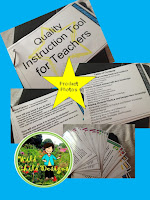"Raindrops on roses, and whiskers on kittens...bright copper kettles and warm woolen mittens...
brown paper packages tied up with string...these are a few of my favorite things..."
Ahhhh. Shades of my 6th grade talent show performance. I'm overcome with nostalgia!
I'm linking up this month with Southern Fried Teachin' to write about my favorite holiday things. In keeping with the seasonal song "The Twelve Days of Christmas," there are, of course, twelve items on my list.
#1 Favorite Holiday Song:
"God Rest Ye Merry Gentlemen" by the Bare Naked Ladies and Sarah McClachlan
I love the harmonies they create together. I also love the history of this song. Did you know it is over 500 years old and was created by peasantry? It contrasted starkly with the Latin Christmas hymns of the day. Yes, I am a musician AND a history freak.
#2 Guilty Pleasure Holiday Food:
Pepperoni rolls! No, I do not mean pizza rolls or calzones. I am talking about homemade bread baked with sticks of pepperoni in it. This delicacy is made in communities in West Virginia where I was born, and where my father is from. The greasy goodness from the pepperoni bakes into the bread. It is eyes-roll-back-in-your-head good.
#3 Favorite Holiday Tradition:
My mom and I always go to the choral service on Christmas Eve. We are usually singing in the choir together, or I'm performing on the piano. This Christmas, with mom being sick, the tradition will change.
#4 Favorite Holiday Book:
I love this story and its lesson. We are happiest when we are giving. If you're not familiar with this book yet, you need to be!
#5 My Favorite Act of Kindness:
There was a man at the gas station I had stopped at. He was elderly. He asked the cashier if he could pump gas and pay him a few days later. The cashier told him it was okay to do this. When I got up to the counter, the cashier explained how this elderly man supplemented his social security by delivering papers. That's why he needed the gas. I paid for his $16 worth of gas. When the cashier told him that it was taken care of, the man burst into tears. I cried watching him from my parked car. Anyone of us could be that man. Sometimes, we forget.
#6 My Favorite Holiday Memory:
I must have been about 11 years old. We had gone to the midnight choral service on Christmas Eve. I came out to the parking lot by myself while my mom put away choir robes. It had begun to snow, and when I looked up into the sky, I couldn't tell what was stars and what was snow. I felt so much happiness in that moment. I still remember throwing my arms up and open and spinning until I fell over. Isn't it strange, the things we remember from our childhoods?
#7 My Favorite Holiday Gift:
My mom took my marathon t-shirts and had a quilt made for me. It means so much to me, because it was her way of cheering me on.
#8 My Favorite Holiday Craft:
Seriously? COOKIES. I've never met a cookie I didn't like. Enough said.
#9 My Favorite Holiday Movie:
"It's a Wonderful Life." Who doesn't want to know that they've made a difference in the world?
#10 My Favorite Place to Shop for Holiday Gifts:
T.J. Maxx! I'm a garage-sale-loving, antique-hunting kind of girl. T.J. Maxx is A LOT like a scavenger hunt. I enjoy finding the unexpected treasures!
#11 What I Want Santa to Bring Me:
What I really, really, really want is to be able to complete one more marathon. I'd like to be healthy enough and injury-free enough to have that experience just one more time. There's nothing else like it.
#12 My Favorite Product:
I LOVE this math project, and have for many years. It's creative, challenging, and fun.
I'm hoping your holidays, regardless of what you might celebrate, are filled with peace, hope, and light. Until we meet again, teach on, my friends!
Tracy @
For more fun holiday reads, click here!






































































